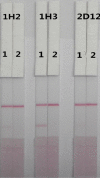Development of Indirect Competitive Enzyme-Linked Immunosorbent Assay and Lateral-Flow Immunochromatographic Strip for the Detection of Digoxin in Human Blood
- PMID: 32010807
- PMCID: PMC6990433
- DOI: 10.1021/acsomega.9b02254
Development of Indirect Competitive Enzyme-Linked Immunosorbent Assay and Lateral-Flow Immunochromatographic Strip for the Detection of Digoxin in Human Blood
Abstract
Mouse-mouse hybridoma cell lines producing stable, highly specific monoclonal antibodies with good affinity for the cardiac glycoside digoxin (DIG) were established to construct an indirect enzyme-linked immunosorbent assay and lateral-flow immunochromatographic strip to detect DIG in human blood. The hapten DIG was coupled to bovine serum albumin or chicken ovalbumin by sodium periodate oxidation. The highest sensitivity and specificity antibody had a median inhibitory concentration (IC50) of 0.45 ng/mL, a linear range of detection of 0.293-0.7 ng/mL, and low cross-reactivity with several DIG analogues. The cut-off value of the lateral-flow immunochromatographic strip was 5 ng/mL when the strip was tested with human blood. The immunochromatographic lateral flow strip test provides a quick and convenient method for determining DIG in plasma which can be visually observed in only 5 min to promote rational drug use.
Copyright © 2020 American Chemical Society.
Conflict of interest statement
The authors declare no competing financial interest.
Figures





Similar articles
-
Determination of robenidine in shrimp and chicken samples using the indirect competitive enzyme-linked immunosorbent assay and immunochromatographic strip assay.Analyst. 2021 Jan 21;146(2):721-729. doi: 10.1039/d0an01783c. Epub 2020 Nov 24. Analyst. 2021. PMID: 33231576
-
Development of Indirect Competitive Enzyme-Linked Immunosorbent and Immunochromatographic Strip Assays for Tiamulin Detection in Chicken.ACS Omega. 2018 Mar 28;3(3):3581-3586. doi: 10.1021/acsomega.8b00289. eCollection 2018 Mar 31. ACS Omega. 2018. PMID: 31458609 Free PMC article.
-
A gold-based immunochromatographic strip for the detection of sirolimus in human whole blood.Analyst. 2022 Mar 28;147(7):1394-1402. doi: 10.1039/d1an02297k. Analyst. 2022. PMID: 35234223
-
Preparation of an anti-isoprocarb monoclonal antibody and its application in developing an immunochromatographic strip assay.Biomed Chromatogr. 2019 Nov;33(11):e4660. doi: 10.1002/bmc.4660. Epub 2019 Aug 27. Biomed Chromatogr. 2019. PMID: 31325166
-
[Preparation of an anti-cotinine monoclonal antibody and its application in immunological detection].Zhejiang Da Xue Xue Bao Yi Xue Ban. 2020 Dec 25;49(6):765-771. doi: 10.3785/j.issn.1008-9292.2020.12.12. Zhejiang Da Xue Xue Bao Yi Xue Ban. 2020. PMID: 33448180 Free PMC article. Chinese.
Cited by
-
Sensitive Lateral Flow Immunoassay for the Residues of Imidocarb in Milk and Beef Samples.ACS Omega. 2021 Jan 18;6(4):2559-2569. doi: 10.1021/acsomega.0c04422. eCollection 2021 Feb 2. ACS Omega. 2021. PMID: 33553874 Free PMC article.
References
-
- Lam P. H.; Bhyan P.; Arundel C.; Dooley D. J.; Sheriff H. M.; Mohammed S. F.; et al. Digoxin use and lower risk of 30-day all-cause readmission in older patients with heart failure and reduced ejection fraction receiving beta-blockers. Clin. Cardiol. 2018, 41, 406–412. 10.1002/clc.22889. - DOI - PMC - PubMed
LinkOut - more resources
Full Text Sources
Other Literature Sources
